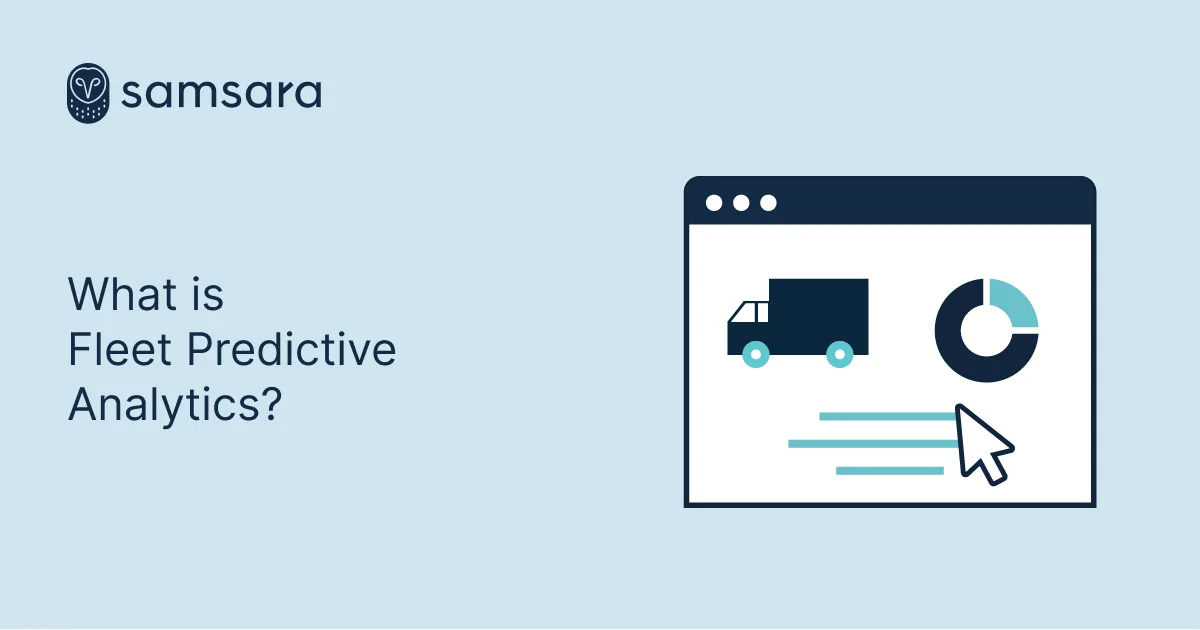What is Fleet Predictive Analytics?
October 22, 2021

Get Started with Samsara
Check our pricesKey Takeaways
With more data at our disposal, fleet managers can use technology such as fleet predictive analytics to help with decision-making and becoming more efficient. Data captured with fleet telematics helps managers solve problems before they happen. Using software algorithms and artificial intelligence, fleet predictive analytics can identify trends and compare a vehicle’s performance against expected performance, helping managers make informed, proactive decisions.
What is fleet predictive analytics?
Fleet predictive analytics uses many techniques from aggregated drivers’ histories, statistics, modeling, and machine learning to analyze current data to make predictions regarding (but limited to) maintenance, budgets, fuel costs, and safety.
How does fleet predictive analytics work
Today’s business decisions are based on data. Through technologies like the Industrial Internet of Things (IIoT), people have more data at their disposal than ever before. Big data technology lets companies harness that information and enables them to make informed decisions.
This is where fleet management systems with predictive analytics come in handy. The data captured from fleet telematics helps managers solve problems before they happen. Businesses use fleet software to constantly monitor real-time data from vehicle sensors, transportation management systems, and more. While mining this data, fleet managers can predict problems, spot trends, and identify behavior patterns.
At a basic level, fleet predictive analytics is made up of three steps:
Capturing data. Equipment sensors generate data.
Transmitting data. The captured data is shared with fleet software via a wired or wireless internet connection.
Analyzing data. Software algorithms with artificial intelligence (AI) technology identify trends and compare a vehicle’s performance against expected performance (often based on OEM guidelines or historical data.) It can also factor in things like natural deterioration. Once computed, the software can make predictions about equipment and vehicles.
When data gets analyzed, the system generates a score for the likelihood of an event occurring. When the score is higher, the more likely the event will occur. For instance, in route optimization, predictive analytics leverages data from prior traffic conditions, work details, satellite information, and scheduling needs. Then, it uses an algorithm to create the most cost-effective route to complete jobs. The analytics tool will generate scores for problems like traffic, accidents, or other delays, and reroute drivers accordingly.
Use cases for predictive analytics in fleet management
Predictive analytics tools are incredibly useful for helping fleet operations become more efficient. Fleet managers can use it to make proactive decisions instead of reacting to problems as they happen. Fleet predictive analytics helps businesses:
Improve fleet efficiency
Fleet predictive analytics tools help with efficiency in several different ways. One significant way is through route optimization. Fleet managers and dispatchers can use analytics to determine the most efficient, cost-effective routings. This is particularly beneficial for fleets that make many stops during the day or whose stops change like waste refuse trucks or delivery vans.
Previously, route optimization was handled manually, but today routes are analyzed in real time with fleet management software. Predictive analytics can look at all the stops on a route, account for delays and historical trip data, and create a path to help drivers complete jobs quickly and efficiently. Because fuel costs are a significant expense for fleets, having efficient routes helps save fuel leading to increased cost-savings.
Another use for predictive analytics is understanding asset utilization. Instead of relying on paper trails and memory, data can show which vehicles or pieces of equipment are underused or need servicing after heavy use. By tracking usage over time, data analytics helps fleet managers redeploy assets more efficiently or sell the asset to streamline upkeep costs if it’s not needed.
Implement predictive maintenance
By investing in predictive maintenance technology, fleets are investing in the long-term health of their equipment or fleets. Implementing a predictive maintenance program extends the lifespan of vehicles and equipment. With sensors and software constantly monitoring performance, managers are preventing real damage from occurring. The software is doing all of the condition monitoring, giving fleet managers peace of mind and allowing them to focus on other tasks.
Also, with predictive analytics keeping track of a vehicle or equipment’s health, businesses experience less unexpected downtime. Managers can schedule maintenance before a breakdown or failure happens, which leads to better service for customers and reliable operations for the business.
Reduced emissions
According to Deloitte, poor vehicle maintenance can lead to an overall 5-20% decrease in productivity and efficiency. Predictive analytics can help fleets implement a preventative maintenance program, ensuring vehicles are fully optimized. This helps enable vehicles to burn fuel properly, reducing carbon emissions. With predictive analytics, sensors monitoring equipment and vehicles can detect greenhouse gas emissions faster than traditional methods. Predictive software can detect potential vehicle and asset failure before releasing harmful emissions or toxic materials.
Promotes driver safety
Predictive analytics tools not only promote safety through consistent fleet maintenance but also encourages safe driving behavior. Today’s fleet management software and telematics data allow managers to track unsafe driving behaviors such as hard braking, harsh turns, and rapid acceleration. Artificial intelligence can also detect when drivers seem distracted or drowsy and warn fleet managers to take corrective action.
Previously, it was difficult to pinpoint consistent trends in unsafe driver behavior. Now, predictive analytics helps managers target drivers exhibiting unsafe behaviors, allowing managers to focus their time on coaching them and helping them improve. When paired with video-based safety solutions, managers can get more context into what their data points are telling them. For example, managers can see if a hard braking incident was due to driver distraction or if the driver was cut off by another vehicle.